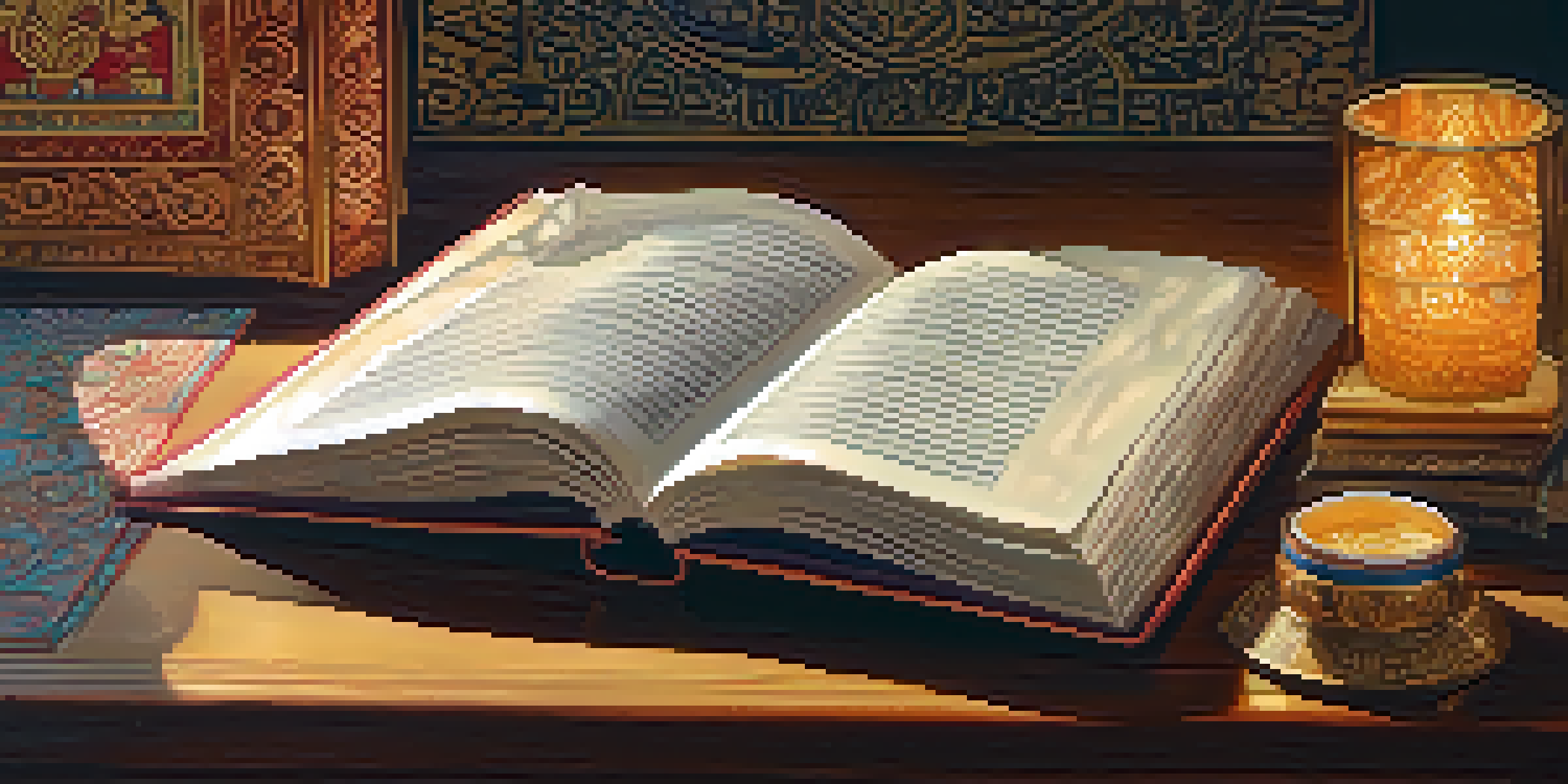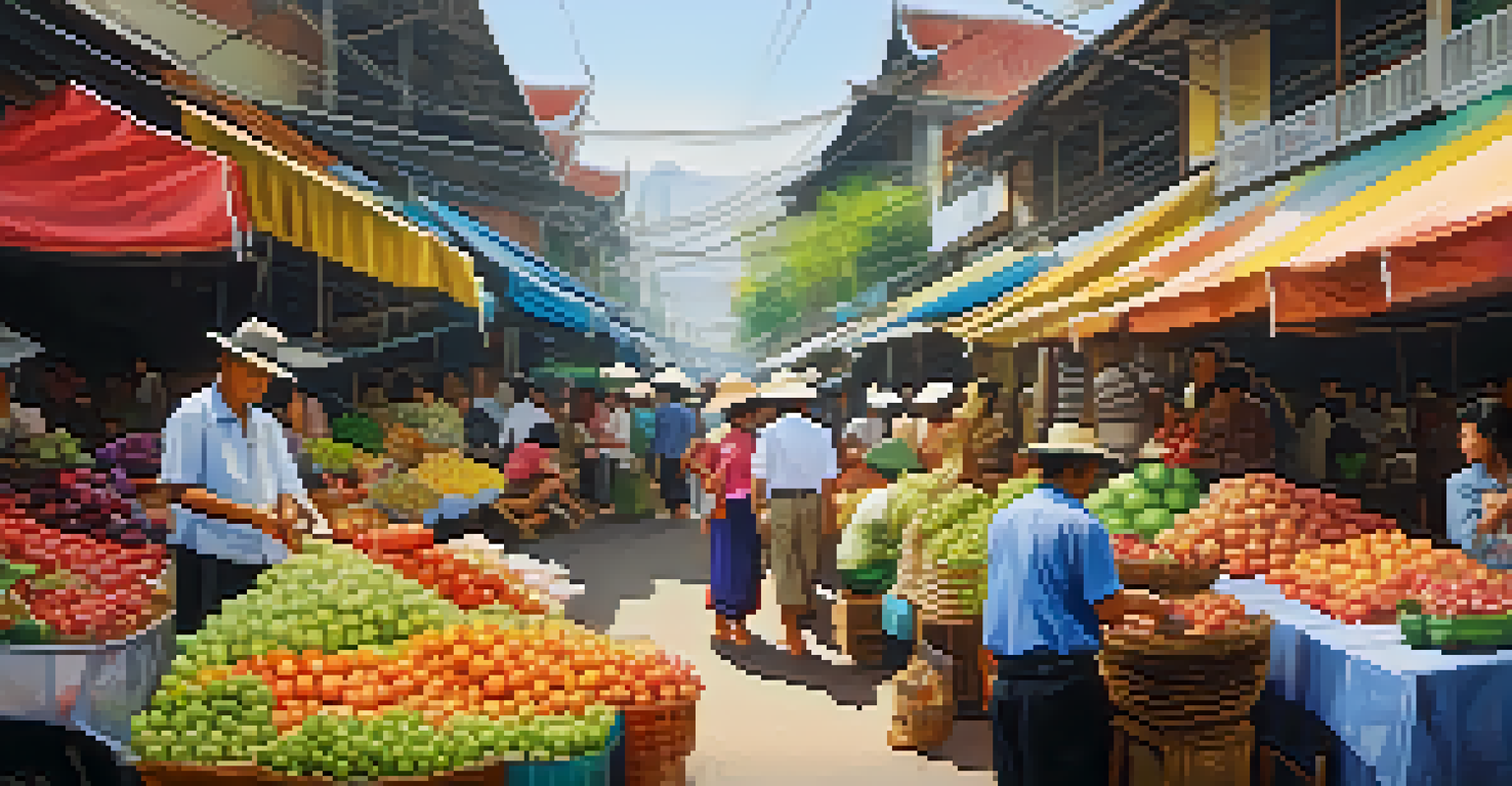Exploring Traditional Thai Literature and Its Cultural Significance

Understanding the Roots of Thai Literature
Traditional Thai literature has deep roots that intertwine with the country's history and culture. Emerging from the ancient kingdom of Sukhothai, it reflects the values, beliefs, and experiences of the Thai people. The earliest texts, often composed in Pali and Sanskrit, laid the groundwork for a unique literary tradition that evolved over centuries.
Literature is the most agreeable way of ignoring life.
As we trace the evolution of Thai literature, we find that it encompasses a diverse range of genres, from poetry and drama to narratives and folklore. Each genre serves as a mirror to society, showcasing the ideals and struggles of its time. This rich tapestry not only entertains but also educates, preserving the cultural heritage for future generations.
Moreover, understanding these roots is essential for appreciating the complexity of Thai language and artistry. The interplay between language and culture creates a vibrant literary scene that continues to thrive today, making it a crucial aspect of Thailand's national identity.
Key Literary Works and Their Themes
Thai literature boasts several iconic works that have shaped its narrative landscape. One of the most significant is the 'Ramayana,' known in Thailand as the 'Ramakien.' This epic poem weaves together themes of love, loyalty, and the struggle between good and evil, resonating deeply with Thai cultural values.

Another important work is 'Phra Aphai Mani,' a poem by Sunthorn Phu that combines folklore and fantasy. It tells the story of a prince and his adventures, emphasizing the themes of freedom, love, and destiny. Such narratives not only entertain but also provide moral lessons, reflecting the wisdom of the ages.
Roots of Thai Literature Explored
Traditional Thai literature reflects the country's rich history and cultural values, evolving from ancient texts to a vibrant literary scene.
Through these works, we see how traditional Thai literature captures the essence of societal values and aspirations. They serve as a conduit for understanding the collective psyche of the Thai people, offering insights into their hopes, fears, and dreams.
The Role of Folktales in Thai Culture
Folktales hold a cherished place in Thai literature, often passed down through generations. These stories, rich with fantastical elements and moral lessons, serve to educate and entertain the young. They often feature animals and mythical creatures, making them relatable and engaging for listeners of all ages.
The greatest gift is a passion for reading. It is cheap, it consoles, it distracts, it excites. It gives you knowledge of the world and experience of a wide kind.
The moral teachings embedded in these folktales reflect the societal values and ethics upheld by the Thai community. For instance, stories about honesty and bravery not only entertain but also instill important life lessons. This cultural practice strengthens community bonds as families gather to share these tales, keeping traditions alive.
Moreover, folktales are a vibrant part of Thailand's cultural identity, illustrating the creativity and imagination of its people. They serve as a reminder of the importance of storytelling in preserving cultural heritage and fostering a sense of belonging.
Traditional Poetry: A Reflection of Thai Society
Traditional Thai poetry, especially forms like 'klon' and 'chan,' captures the essence of the Thai experience. These structured forms allow poets to express emotions, celebrate nature, and reflect on societal issues. The rhythmic patterns and vivid imagery in these poems create a musicality that resonates with readers and listeners alike.
Moreover, poetry often serves as a medium for social commentary, addressing issues such as love, loss, and the passage of time. Through the lens of poetic expression, we gain insights into the cultural and historical contexts that shape Thai society. Poets like Sunthorn Phu have used their craft to voice the collective sentiments of their time.
Folktales: Cultural Education Tools
Folktales in Thai culture provide moral lessons and strengthen community bonds, showcasing the creativity and imagination of the Thai people.
In essence, traditional poetry is not just an art form but a significant cultural artifact. It connects individuals to their heritage while fostering a deep appreciation for the beauty of the Thai language.
Influences of Buddhism on Thai Literature
Buddhism has profoundly influenced Thai literature, shaping its themes, narratives, and moral undertones. The teachings of the Buddha emphasize compassion, mindfulness, and the quest for enlightenment, all of which are reflected in literary works. This spiritual framework provides a rich backdrop for exploring the complexities of human emotions and relationships.
Many traditional texts incorporate Buddhist parables and principles, offering readers moral guidance and philosophical insights. For instance, stories often highlight the importance of karma and the cyclical nature of life, reminding individuals of their actions' consequences. Such themes resonate deeply within Thai culture, reinforcing the values upheld by the community.
Consequently, the influence of Buddhism enriches Thai literature, making it a unique blend of spirituality and artistry. It fosters a deeper connection between literature and the lived experiences of those who engage with it.
Modern Adaptations of Traditional Literature
As Thailand progresses into the modern era, traditional literature has found new life through adaptations and reinterpretations. Contemporary authors are weaving traditional themes and narratives into modern contexts, creating a bridge between the past and present. This evolution allows younger generations to connect with their cultural heritage in relatable ways.
For instance, modern novels and films often draw inspiration from classic tales, reimagining characters and settings to resonate with today's audience. This not only revitalizes interest in traditional stories but also demonstrates their timeless relevance. It showcases the adaptability of Thai literature, proving that its themes can transcend time.
Modern Adaptations Revive Tradition
Contemporary authors are reinterpreting traditional literature, bridging the past and present to connect younger generations with their cultural heritage.
Moreover, these adaptations spark discussions about identity, culture, and the role of tradition in a rapidly changing world. They encourage reflection on how literature can evolve while still honoring its roots, making it a vital part of Thailand's cultural landscape.
Preserving Thai Literary Heritage for Future Generations
Preserving traditional Thai literature is crucial for maintaining the cultural identity of the nation. Efforts to document and promote these literary works ensure that future generations can appreciate and learn from their rich heritage. Various organizations and educational institutions are actively involved in this preservation, organizing workshops, lectures, and exhibitions.
In addition, digital platforms are emerging as valuable tools for sharing and preserving traditional texts. Online libraries and resources make these works accessible to a global audience, fostering appreciation and understanding of Thai literature beyond its borders. This technological advancement plays a significant role in keeping the literary tradition alive.

Ultimately, the preservation of Thai literature is not just about safeguarding texts; it’s about nurturing the collective memory of the Thai people. It empowers individuals to embrace their cultural roots while inspiring creativity and innovation in future literary endeavors.